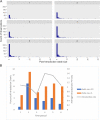Changing genomic epidemiology of COVID-19 in long-term care facilities during the 2020-2022 pandemic, Washington State
- PMID: 38225567
- PMCID: PMC10789038
- DOI: 10.1186/s12889-023-17461-2
Changing genomic epidemiology of COVID-19 in long-term care facilities during the 2020-2022 pandemic, Washington State
Abstract
Background: Long-term care facilities (LTCFs) are vulnerable to disease outbreaks. Here, we jointly analyze SARS-CoV-2 genomic and paired epidemiologic data from LTCFs and surrounding communities in Washington state (WA) to assess transmission patterns during 2020-2022, in a setting of changing policy. We describe sequencing efforts and genomic epidemiologic findings across LTCFs and perform in-depth analysis in a single county.
Methods: We assessed genomic data representativeness, built phylogenetic trees, and conducted discrete trait analysis to estimate introduction sizes over time, and explored selected outbreaks to further characterize transmission events.
Results: We found that transmission dynamics among cases associated with LTCFs in WA changed over the course of the COVID-19 pandemic, with variable introduction rates into LTCFs, but decreasing amplification within LTCFs. SARS-CoV-2 lineages circulating in LTCFs were similar to those circulating in communities at the same time. Transmission between staff and residents was bi-directional.
Conclusions: Understanding transmission dynamics within and between LTCFs using genomic epidemiology on a broad scale can assist in targeting policies and prevention efforts. Tracking facility-level outbreaks can help differentiate intra-facility outbreaks from high community transmission with repeated introduction events. Based on our study findings, methods for routine tree building and overlay of epidemiologic data for hypothesis generation by public health practitioners are recommended. Discrete trait analysis added valuable insight and can be considered when representative sequencing is performed. Cluster detection tools, especially those that rely on distance thresholds, may be of more limited use given current data capture and timeliness. Importantly, we noted a decrease in data capture from LTCFs over time. Depending on goals for use of genomic data, sentinel surveillance should be increased or targeted surveillance implemented to ensure available data for analysis.
Keywords: Epidemiology; Genomics; Healthcare-associated Infections; Public health; SARS-CoV-2; Surveillance.
© 2024. The Author(s).
Conflict of interest statement
The authors declare no competing interests.
Figures




Similar articles
-
Genomic Epidemiology and Transmission Dynamics of Severe Acute Respiratory Syndrome Coronavirus 2 (SARS-CoV-2) in Congregate Healthcare Facilities in Santa Clara County, California.Clin Infect Dis. 2022 Mar 9;74(5):829-835. doi: 10.1093/cid/ciab553. Clin Infect Dis. 2022. PMID: 34328176 Free PMC article.
-
Early Adoption of Longitudinal Surveillance for SARS-CoV-2 among Staff in Long-Term Care Facilities: Prevalence, Virologic and Sequence Analysis.Microbiol Spectr. 2021 Dec 22;9(3):e0100321. doi: 10.1128/Spectrum.01003-21. Epub 2021 Nov 10. Microbiol Spectr. 2021. PMID: 34756092 Free PMC article.
-
Sequencing analysis of SARS-CoV-2 cases in Slovenian long-term care facilities to support outbreak control.Front Public Health. 2024 May 15;12:1406777. doi: 10.3389/fpubh.2024.1406777. eCollection 2024. Front Public Health. 2024. PMID: 38813418 Free PMC article.
-
The role of viral genomics in understanding COVID-19 outbreaks in long-term care facilities.Lancet Microbe. 2022 Feb;3(2):e151-e158. doi: 10.1016/S2666-5247(21)00208-1. Epub 2021 Sep 29. Lancet Microbe. 2022. PMID: 34608459 Free PMC article. Review.
-
Sentinel Surveillance System Implementation and Evaluation for SARS-CoV-2 Genomic Data, Washington, USA, 2020-2021.Emerg Infect Dis. 2023 Feb;29(2):242-251. doi: 10.3201/eid2902.221482. Epub 2023 Jan 3. Emerg Infect Dis. 2023. PMID: 36596565 Free PMC article. Review.
References
-
- Washington State Department of H. COVID-19 Long Term Care Monthly Report. https://doh.wa.gov/sites/default/files/2022-02/Weekly-COVID-19-Long-Term.... Accessed 10 Apr 2023.
-
- Kimball A, Hatfield KM, Arons M, James A, Taylor J, Spicer K, et al. Asymptomatic and Presymptomatic SARS-CoV-2 Infections in Residents of a Long-Term Care Skilled Nursing Facility — King County, Washington, March 2020. MMWR Morb Mortal Wkly Rep. 2020;69(13):377–381. doi: 10.15585/mmwr.mm6913e1. - DOI - PMC - PubMed
-
- Center for Disease Control and Prevention. Preparing for COVID-19 in Nursing Homes | CDC. https://www.cdc.gov/coronavirus/2019-ncov/hcp/long-term-care.html. Accessed 10 Apr 2023.
Publication types
MeSH terms
Grants and funding
LinkOut - more resources
Full Text Sources
Medical
Miscellaneous

